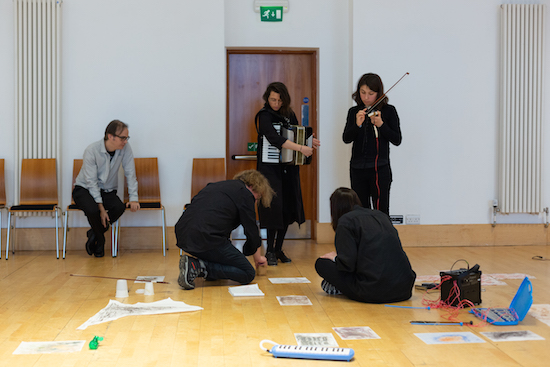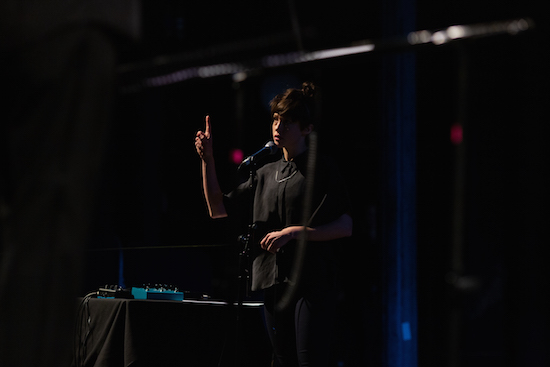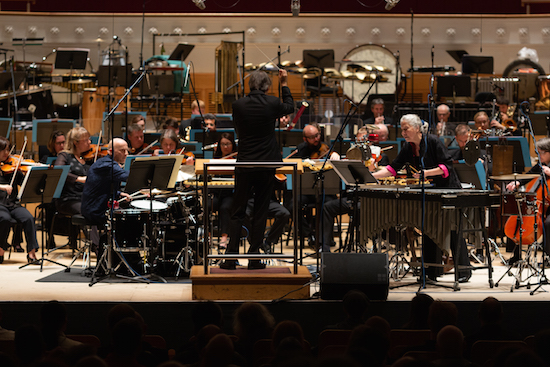At Tectonics, going from a new music performance by the BBC Scottish Symphony Orchestra to the curiously touching voice and keyboard antics of Mik Quantius seems like the most natural thing in the world: such is the beauty of Ilan Volkov and Alasdair Campbell’s festival, now in its seventh year.
There’s nothing gimmicky or forced about it: the curators understand that audiences want to hear something different or new, whether it’s contemporary composition or underground weirdness. So we get new works from composers Sarah Davachi, Mauro Lanza and Genevieve Murphy, alongside the participatory surrealism of Angela Sawyer and the stunning 12-string guitar of Julia Reidy.
It all kicks off on the first floor promenade of the City Halls, with the audience gathering around a cluster of musicians performing Christian Wolff’s Burdocks, a playful piece in which short phrases passed between a classroom assemblage of small instruments. The American composer has roped in several of the weekend’s artists to realise his score: Jennifer Walshe jabs at a keyboard and Martin Arnold toots a melodica, while master percussionists Joey Barton and Robyn Schulkowsky weave through the crowd wielding resonant trinkets. At the bottom of the stairs, Czech composer Lucie Vítková and her ensemble add their contributions on glockenspiel, accordion and found objects. The musicians follow a detailed score, an intriguing mix of standard notation, graphics and text. Timing is clearly of the essence, but I’d wager there’s a degree of improvisation involved, along with an embrace of imperfection that gently resists classical convention.
It’s a lovely opening to the festival, and flows almost seamlessly into Vítková’s six-hour installation-performance in the Recital Room. Accompanied by Maya Verlaak, Suze Whaites and Jorge Boehringer, Vítková performs scores drawn with out-of-date makeup. Audience members can choose a score for the group to perform: some even join in. The scores are laid out across the floor around small islands of musical instruments and sound-making devices. It’s a delight to dip in and out of the installation. At one point I observe White dragging an upturned ramekin around the wooden floor, mirroring the twisting lines on the score before her. Other readings of the scores are more inscrutable. Die are cast, electronic gadgets are tweaked, objects are shaken, scraped, caressed. The focus is on small sounds and gestures, but it’s always well balanced, with a real sense of communication between the performers.

We return to Wolff later that evening with the World Premier of Old Shoe, New Shoe, ‘a sonic landscape for orchestra and two solo percussionists’. Volkov conducts the SSO, with Baron playing trap kit and Schulkowsky surrounded by a battery of drums, cymbals and gongs. I’m taken back to seeing Colin Currie performing James MacMillan’s percussion concerto in the same venue a few months prior. In that piece, the Scottish percussionist cavorted across the stage, showing his chops on everything from bongos to timpani. For all the spectacle, it felt a little corny, with the music too steeped in European traditions to create any kind of rhythmic or textural intrigue. There are no such issues with Wolff’s compellingly kinetic piece. Baron is best known as a jazz drummer, and he brings a dynamism and swing to the piece, almost breaking into a funk groove at one point. Although he and Schulkowsky make their presence felt, they are fully integrated members of the orchestra, rather than stunt soloists. Their contributions reflect and intensify the rhythms and textures of the orchestra, whether its the accents Baron adds to the jagged cello motifs, or the shimmering metallics Schulkowsky lays over the otherworldly string and brass harmonies.
Harpsichord virtuoso Mahan Esfahani is very much a star soloist, but his pieces are carefully chosen to expand the possibilities of the instrument. He opens with George Lewis’ Timelike Wave, a composition inspired by Afrodiasporic quilting aesthetics. The programme notes suggest a meeting of Milton Babbit, McCoy Tyner and Evan Parker, which is a pretty neat summation of the AACM member’s absorption of 20th century avant-gardes. There’s an echo of Parker in the dense flurries of notes that fly from Esfahani’s fingertips. The spindly tone of the harpsichord allows for a clearer articulation than would be possible on the piano, and the intensity and speed with which Esfahani works these passages is mind boggling. As befitting the title, fragments of stride and modal jazz are woven into the shifting harmonies and rippling chordal figures. At climactic points, Esfahani pummels the keyboard with his fists, and it’s almost shocking to see such a delicate instrument being treated like this. The physicality of his playing brings to mind free jazz masters like Cecil Taylor, but he lacks that genius’ balletic grace.
Anahita Abbasi’s Intertwined Distances enhances Esfahani’s playing with electronic elements. At first, these are fairly discreet, with textures and tones complementing Esfahani’s playing, but it soon becomes a tussle between man and machine, as Esfahani’s playing is processed and thrown back at him. Miroslav Srnka’s Triggering focuses on the harpsichord’s interior, with Esfahani laying an Ebow on the strings until ghostly tones emerge. Later that evening, Esfahani provides one of the festival’s highlights with a performance of Luc Ferrari’s Programme commun pour clavecin amplife et band magnetique. It’s notable how well-balanced the elements are, with the tape playing as central a role as the harpsichord. The tape hums and warbles behind scurrying high-end figures, before morphing into long tones that swoop around the space, punctuated by oblique chords.

Receiving its UK premiere, Jennifer Walshe’s The Site of an Investigation drew a range of responses, from the rapturous to the risible. I can understand why it wound some people up the wrong way: there are certain aspects to the Irish composer’s work that might suggest it’s all a great big laugh, lads. The text, which she sings and recites in a range of voices, draws on the language of social media and tech billionaires, while the music flirts with bombast and pastiche. There are jarring tonal shifts, as Walshe moves from conversational patter to raw explorations of trauma and loss. Some parts are genuinely moving; others provoke a mix of emotions. All deliberate of course: Walshe is trying to make sense of the banality and horror of life under late capitalism through forms that are fragmentary and self-reflexive.
It can be irreverent and meta, as she switches registers and narrative positions, but there’s a real emotional and intellectual force to the piece, as she advocates an eco-feminist politics of empathy and solidarity. In the role of dissembling narrator, Walshe addresses the normalisation of precarity with black humour (‘You see, they pulled a fast one on all of us here now lads’) then sets an unflinching account of a breakdown (‘As I smashed all the pictures, I was crying. While I was crying, I was screaming’) to an uneasy combination of graceful strings and queasy brass. Over mock-heroic Hollywood strings, Walshe derides tech billionaires’ elitist fantasies of space-colonisation: ‘are we going to allow ourselves to, to, to sort of wreck another planet, simply because it’s too exciting not to?’ In purely formal terms, The Site of an Investigation is not particularly radical. But through her juxtaposition of elements and ideas, Walshe is challenging the conventions of concert music and raising questions about its relationship with society. As she sings, ‘the finished work is made of simple elements. It is brutal and it is beautiful’.


